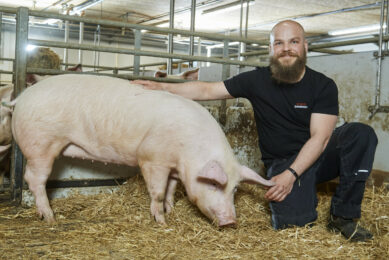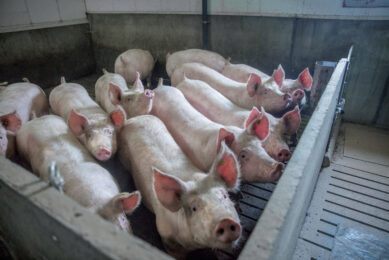Danish ‘bacon pig’ preserved
The Danish Landrace 1970 – also known as the ‘Bacon Pig’ – has received a genetic boost. By using frozen semen, ‘old’ genes have successfully been re-introduced to the breed. This has huge impact on the preservation of the breed.
On a small farm in the central part of Jutland, 10 piglets are unaware of their significance for the preservation of the old Danish pig breed, Danish Landrace dating back to 1970. They have been brought into this world using 16-year-old frozen semen from a boar not previously used for breeding. This may help preserve the breed in its original form.
“Today, all production pigs are crosses of two or three different breeds. There are very few animals of the original Danish Landrace left compared to 1970 when it was regarded as the world’s best,” says Torkild Liboriussen, a retired scientist at Aarhus University.
Inbreeding threatens Danish Landrace 1970
The population of the Danish Landrace 1970 is very small, and it is characterised by a very high degree of inbreeding, which may cause diseases, problems with reproduction, etc., which complicates efforts to preserve the breed. There is a need for a sustainable breeding plan to maintain the breed. That is why the piglets on the farm in the central part of Jutland are of great importance.
The population of the Danish Landrace 1970 is very small, and it is characterised by a very high degree of inbreeding, which may cause diseases, problems with reproduction, etc., which complicates efforts to preserve the breed. There is a need for a sustainable breeding plan to maintain the breed. That is why the piglets on the farm in the central part of Jutland are of great importance.
“Two or three boars from the new litter are going to be used as breeding animals which will reduce inbreeding,” says Torkild Liboriussen.
It is important that Danish Landrace 1970 is maintained as a pure breed, as genes from the breed may be of importance in pig breeding in the future. It is also important to preserve the breed for purely historical reasons.
“The Danish Landrace 1970 is a part of our cultural history, and it is therefore essential to preserve the breed as it was when it was the best in the world. The new litter of piglets is an example of how we can supplement and maintain a breed,” says Torkild Liboriussen.
Pet pig became a breeding pig
The use of the frozen semen to give the Danish Landrace 1970 a revival was an initiative coming from Lise Lund Andersen. Some years ago she bought a 30-kg Danish Landrace sow as the family’s pet pig. At that time, she did not intend to use the sow for breeding.
The use of the frozen semen to give the Danish Landrace 1970 a revival was an initiative coming from Lise Lund Andersen. Some years ago she bought a 30-kg Danish Landrace sow as the family’s pet pig. At that time, she did not intend to use the sow for breeding.
However, in 2011 she decided that she would contribute to the preservation of the Danish Landrace.
“I was interested in supporting the preservation of the Danish Landrace 1970, and to do so I decided to inseminate the sow with frozen semen from an old Landrace boar,” says Lise Lund Andersen, who is co-founder and former chairman of the breeding committee for the conservation of the Danish Landrace pigs.
Andersen has worked as manager of a modern breeding herd and has extensive experience in insemination of sows.
“Although I have only hitherto used fresh semen, the principles are the same,” says Andersen.
She contacted the secretary of the Genetic Resources Committee Helle Palmø in the Danish AgriFish Agency. The Genetic Resources Committee, whose mandate expired at the end of 2011, had the task to support preservation of Danish livestock genetic resources. The committee’s gene bank, situated at AU Foulum, has frozen semen from seven different boars and frozen embryos. The genetic material is from 1996 and originates from a control line of the Danish Landrace of 1970 from the closed “Tylstrup” experimental station.
Andersen was offered four portions of boar semen and the insemination resulted in 13 piglets. One was stillborn and two died after birth. However, 10 live piglets in a litter are quite impressive when using artificial insemination with frozen semen.
“The piglets are living proof that the frozen semen is functional and that the gene bank thus has the potential of preserving the Danish Landrace 1970,” says Vivi Hunnicke Nielsen, associate professor at Aarhus University and former member of the Genetic Resources Committee.
For more information: Associate Professor Vivi Hunnicke Nielsen – vivih.nielsen@agrsci.dk
Source: Aarhus University











